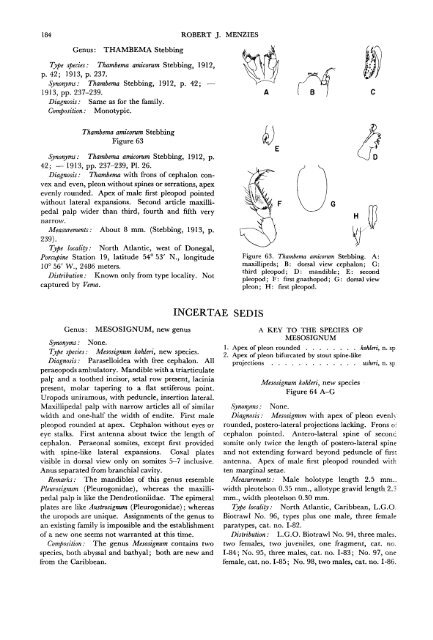The Isopods of Abyssal Depths in the Atlantic Ocean
The Isopods of Abyssal Depths in the Atlantic Ocean
The Isopods of Abyssal Depths in the Atlantic Ocean
Create successful ePaper yourself
Turn your PDF publications into a flip-book with our unique Google optimized e-Paper software.
184 ROBERT J. MENZIES<br />
Genus: THAMBEMA Stebb<strong>in</strong>g<br />
Type species: Thambema amicorum Stebb<strong>in</strong>g, 1912,<br />
p. 42; 1913, p. 237.<br />
Synonyms: Thambema Stebb<strong>in</strong>g, 1912, p. 42; —<br />
1913, pp. 237-239.<br />
Diagnosis: Same as for <strong>the</strong> family.<br />
Composition: Monotypic.<br />
Thambema amicorum Stebb<strong>in</strong>g<br />
Figure 63<br />
Synonyms: Thambema amicorum Stebb<strong>in</strong>g, 1912, p.<br />
42; — 1913, pp. 237-239, PI. 26.<br />
Diagnosis: Thambema with frons <strong>of</strong> cephalon convex<br />
and even, pleon without sp<strong>in</strong>es or serrations, apex<br />
evenly rounded. Apex <strong>of</strong> male first pleopod po<strong>in</strong>ted<br />
without lateral expansions. Second article maxillipedal<br />
palp wider than third, fourth and fifth very<br />
narrow.<br />
Measurements: About 8 mm. (Stebb<strong>in</strong>g, 1913, p.<br />
239).<br />
Type locality: North <strong>Atlantic</strong>, west <strong>of</strong> Donegal,<br />
Porcup<strong>in</strong>e Station 19, latitude 54° 53' N., longitude<br />
10° 56' W., 2486 meters.<br />
Distribution: Known only from type locality. Not<br />
captured by Vema.<br />
Genus: MESOSIGNUM, new genus<br />
INCERTAE<br />
Synonyms: None.<br />
Type species: Mesosignum kohleri, new species.<br />
Diagnosis: Paraselloidea with free cephalon. All<br />
peraeopods ambulatory. Mandible with a triarticulate<br />
palp and a too<strong>the</strong>d <strong>in</strong>cisor, setal row present, lac<strong>in</strong>ia<br />
present, molar taper<strong>in</strong>g to a flat setiferous po<strong>in</strong>t.<br />
Uropods uniramous, with peduncle, <strong>in</strong>sertion lateral.<br />
Maxillipedal palp with narrow articles all <strong>of</strong> similar<br />
width and one-half <strong>the</strong> width <strong>of</strong> endite. First male<br />
pleopod rounded at apex. Cephalon without eyes or<br />
eye stalks. First antenna about twice <strong>the</strong> length <strong>of</strong><br />
cephalon. Peraeonal somites, except first provided<br />
with sp<strong>in</strong>e-like lateral expansions. Coxal plates<br />
visible <strong>in</strong> dorsal view only on somites 5—7 <strong>in</strong>clusive.<br />
Anus separated from branchial cavity.<br />
Remarks: <strong>The</strong> mandibles <strong>of</strong> this genus resemble<br />
Pleurosignum (Pleurogonidae), whereas <strong>the</strong> maxillipedal<br />
palp is like <strong>the</strong> Dendrotioniidae. <strong>The</strong> epimeral<br />
plates are like Austrosignum (Pleurogonidae); whereas<br />
<strong>the</strong> uropods are unique. Assignments <strong>of</strong> <strong>the</strong> genus to<br />
an exist<strong>in</strong>g family is impossible and <strong>the</strong> establishment<br />
<strong>of</strong> a new one seems not warranted at this time.<br />
Composition: <strong>The</strong> genus Mesosignum conta<strong>in</strong>s two<br />
species, both abyssal and bathyal; both are new and<br />
from <strong>the</strong> Caribbean.<br />
Figure 63. Thambema amicorum Stebb<strong>in</strong>g. A:<br />
maxillipeds; B: dorsal view cephalon; G:<br />
third pleopod; D: mandible; E: second<br />
pleopod; F: first gnathopod; G: dorsal view<br />
pleon; H: first pleopod.<br />
SEDIS<br />
A KEY TO THE SPECIES OF<br />
MESOSIGNUM<br />
Apex <strong>of</strong> pleon rounded kohleri, n. sp<br />
Apex <strong>of</strong> pleon bifurcated by stout sp<strong>in</strong>e-like<br />
projections usheri, n. sp<br />
Mesosignum kohleri, new species<br />
Figure 64 A-G<br />
Synonyms: None.<br />
Diagnosis: Mesosignum with apex <strong>of</strong> pleon evenlv<br />
rounded, postero-lateral projections lack<strong>in</strong>g. Frons <strong>of</strong><br />
cephalon po<strong>in</strong>ted. Antero-lateral sp<strong>in</strong>e <strong>of</strong> seconc<br />
somite only twice <strong>the</strong> length <strong>of</strong> postero-lateral sp<strong>in</strong>e<br />
and not extend<strong>in</strong>g forward beyond peduncle <strong>of</strong> first<br />
antenna. Apex <strong>of</strong> male first pleopod rounded with<br />
ten marg<strong>in</strong>al setae.<br />
Measurements: Male holotype length 2.5 mm.,<br />
width pleotelson 0.35 mm., allotype gravid length 2.3<br />
mm., width pleotelson 0.30 mm.<br />
Type locality: North <strong>Atlantic</strong>, Caribbean, L.G.O.<br />
Biotrawl No. 96, types plus one male, three female<br />
paratypes, cat. no. 1-82.<br />
Distribution: L.G.O. Biotrawl No. 94, three males,<br />
two females, two juveniles, one fragment, cat. no.<br />
1-84; No. 95, three males, cat. no. 1-83; No. 97, one<br />
female, cat. no. 1-85; No. 98, two males, cat. no. 1-86.

















